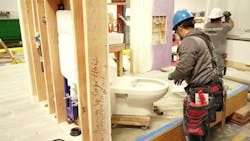Modular Construction Combats the Affordable Housing Crisis
The housing crisis is among this country’s major problems, spawning a host of negative issues that include homelessness, overcrowding and rent-burdened communities. Fueling these challenges has been a stagnant housing market that has barely grown since 1980.
The combination of rising demand with a static housing supply that does not support a growing population means the overall cost of living has painfully increased for renters. California has one of the tightest housing markets in the nation, making affordable housing one of the state’s biggest problems, with Oregon and Washington state facing similar concerns.
Impact Housing
Los Angeles-based Impact Housing is producing functionally designed, stackable apartment modules in their Yorba Linda manufacturing facility, which they assemble into a fully functioning residential building. Their manufacturing expertise and efficiency enables them to deliver housing for low-and-moderate income renters across California.
Committed to giving low and moderate-income families attainable housing, Impact at the same time refuses to sacrifice quality for the sake of cost. This is possible thanks to Impact Housing’s internal design team and their efficient approach to assembling and constructing apartment buildings to maximize usable space.
To carry this intent into the bathrooms within the units, Impact Housing is installing high-quality/high-function in-wall concealed tank and carrier systems for wall-hung toilets carriers and flush plates manufactured by the Geberit Group, a leader in sanitary products worldwide to enhance the quality of the interiors.
The out-of-reach cost of new housing leads to displacement and put decent housing beyond the budgets of local workers, such as teachers, firefighters, and police officers vital for community services. In addition, many of these essential workers must commute an hour or more from home to work, creating additional pollution and stress on an already jammed transportation system.
The rental units Impact Housing produces represent opportunities for families and communities to have that better housing. “They’re for individuals earning low and moderate incomes, so you are talking about a full-time, fully employed 40-hour-a-week workforce; people a city needs to function,” says Impact Housing’s founder and CEO, Drew Orenstein.
A Better Idea for Housing
Founded in 2020, Impact Housing is out to deliver thousands of new units in neighborhoods throughout San Diego. Several of these multi-story buildings will offer street-level retail and dining amenities to improve neighborhood walk-ability. Many will also feature green spaces, balconies, and rooftop terraces to enhance residents’ health and well-being further.High-quality designs, amenities, and attainable price points are made possible by their innovative production model. Modular components are manufactured assembly-line style for speed, sustainability, and quality control. Given California’s strict documentation requirements for new construction, building these units in a controlled location makes the process more cost-effective and time efficient.
They build modules for each studio; one, two, and three-bedroom apartments. Impact Housing produces the modules for a project while the site is prepared for construction. Once complete, the modules ship off to the construction site on flatbed trucks.
Orenstein compares these six-sided modules to Lego blocks. Once construction begins, the trucks arrive in a steady stream, transforming the site from empty to a fully built apartment complex in weeks. When the modules reach the job site, a crane stacks them in place, going as high as six stories for some of their buildings. These buildings have interior hallways, elevators, staircases, and laundry rooms, everything you’d expect from a modern apartment building.
At the Impact Housing factory, everything is focused on efficient design that maximizes usable space. This is especially true in the case of the bathroom. Workers completely install the bathroom with in-wall carriers and wall-mounted toilets. Unlike standard floor-mounted toilets, the Geberit tank and piping are installed in the wall, increasing the usable floor area in the bathroom. The workers then mount the floating toilet, connect the water, and the toilet is flushed and tested. In addition, there are water, waste, and vent tests to validate toilet performance before the bathroom module leaves the factory.
Winning the Game of Square Inches
Impact Housing has established relationships with suppliers to ensure the reliability of the products and the supply chain. The Geberit Southwest Sales Manager, Sharon Clair, initially visited Impact Housing in its first year of business when they had only four employees. 125 people work for the company, and Geberit toilets are a key fixture in their units.
Instead of floor-mounted toilets from a big box store, Clair convinced Impact Housing to install in-wall carriers. “I explained to them what this design could do for them by saving them 6-9 inches of floor space and with seamless integration into wall panel assembly construction line,” explained Sharon. “The Geberit in-wall carriers are universal. They accommodate the leading wall-mounted toilet brands.”
Geberit National Builder Sales Manager Edward Aguilar explains how they worked with Impact Housing to merge the in-wall toilet with their manufacturing process and module design. “Sharon presented a mockup and gave them a product to try, and they realized that the toilet would integrate into their bathroom walls. Geberit partners with architects and modular builders nationwide to enhance bathroom design and improve efficiency practices.”
The compactness of the in-wall carrier is a significant benefit for these units. “The ten inches of space that the toilet saves makes a big difference in the bathroom for the residents in terms of usable space,” says Impact Housing Chief Development Officer Andrew Ranallo. “We can put more space into the liveable areas beyond the bathroom by eliminating the standard floor-mounted toilet tank. This extra space means a resident can have a longer couch or a queen-sized bed rather than a twin.”
Typically, Geberit in-wall carriers are the preferred systems for high-rise residential buildings with rents in the tens of thousands of dollars a month and in upscale homes. While these higher-end residences have plenty of room, the in-wall space-saving design is ideal for Impact-Housing’s smaller units. Moreover, the wall-mounted toilet design makes it easier to clean. Water evacuates the toilet bowl with a push on the wall-mounted plate, which blends in well with the wall. The flush plate is the only visible element of the carrier system. In addition, the toilet system offers a built-in dual flush—a full flush for solid waste and a reduced flush for liquids. The Geberit dual flush system meets California’s green building standards for water efficiency and sustainability, saving thousands of gallons of water yearly.
Access to the carrier system is easy and involves no tools. The carrier’s design minimizes the hassles of toilet maintenance for building managers and tenants. Internal valves are backed with a 10-year warranty, and the tank and carrier hold a manufacturer’s lifetime warranty.
Impact Housing’s relationship doesn’t stop once the tenant moves into the apartment modules. “We continually get customer feedback on what’s working and what isn’t,” according to Ranallo. “Ultimately, we can understand long-term maintenance issues or successes with different products.”
Better Housing is Within Reach
Construction of these new homes will help San Diego fulfill its moderate and low-income housing targets for the current Regional Housing Needs Allocation cycle from 2022 to 2030. Impact Housing will continue its dramatic expansion, increasing housing availability and improving lives across the country.
Geberit in-wall carriers are a small element in the final project. Still, they are vital to enabling Impact Housing to deliver high-quality, sustainable, naturally affordable housing that benefits those living in these apartments and the surrounding community.




